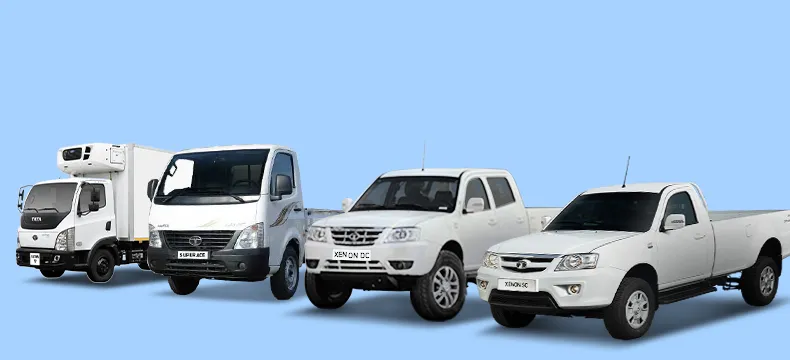25 Sep 2025

Weight Distribution – How it Affects Your Trucks and How it Can Be Checked
- Tata Motors
- 16 Dec 2024
- Commercial Vehicle
Introduction
With trucks, you might have noticed how some trucks handle heavy loads while others feel unstable on the road—the reason for this is the payload capacity and truck weight distribution. Improper weight distribution can cause multiple problems. It can lead to an unstable ride, shorten the life of the truck, and negatively impact its traction and overall safety over time. Hence, ensuring your truck's weight is properly spread across its axles is the key to optimise its performance. Read ahead to learn more about truck weight distribution, its effects, and the techniques to check and ensure optimal weight distribution.
Weight Distribution in Trucks
Truck weight distribution refers to how the vehicle's load is spread across its axles. This includes the weight imposed on the ground at an axle, axles as a group, and the individual wheel. Balancing this distribution is crucial for stability, braking efficiency, and handling. When the weight is unevenly distributed, there is an increased risk of wear and tear, damage to critical components like the suspension, and poor fuel efficiency.
How to Check Weight Distribution in Trucks
Checking truck weight distribution involves understanding various parameters, such as:
-
Drive Axle Weighing
The most basic way to check weight distribution is to measure the load on the front and rear axles. You can do so by driving each axle on the scale individually. The combined weight should be balanced and fall within Morocco's optimum truck axle weight limits.
-
Gross Vehicle Weight (GVW)
Comparing the vehicle's total weight (including the payload) against the GCW is an excellent way to check weight distribution. Your truck could be overloaded if the total weight exceeds the road safety authority's recommended limit in Morocco.
-
Payload Balancing
The position of the load within the truck bed also affects its weight distribution. When the loads are unevenly or poorly placed, they can shift during transit and throw the vehicle off balance. By checking the positioning, you can reduce the risk of accidents.
-
Load-Shift Impact
Depending on the type of business, you may carry different types of payloads. Some loads require more attention than others, like liquids in tankers. You can check how they impact handling to understand weight distribution.
-
Tire Pressure Monitoring
Uneven weight distribution may cause some tyres to bear more load than others. As a result, irregular tyre wear and blowouts can become an issue. Checking the tyre pressure can give you an idea of the weight distribution to avoid such problems.
Payload Distribution Tips
With appropriate payload distribution, you can ensure your vehicle's long-term health and safety. Some simple load-balancing techniques include:
-
Centring Heavy Loads
Placing the heaviest items in the centre of the truck bed, especially close to the axle, is a good payload distribution tip. This ensures the weight is spread evenly and reduces the strain on the axles.
-
Front-to-Back Distribution
The weight distribution must remain balanced front to back. If you load the truck's rear more heavily, you can increase the chances of the front wheels losing traction and vice versa. This will particularly affect the vehicle in challenging driving conditions.
-
Mindfully Checking Loads
It is critical to consider the truck axle weight limits. Exceeding them will reduce fuel efficiency and put unnecessary strain on the tyres. You can investigate the road safety regulations in Morocco and the manufacturer's payload recommendations.
-
Distributing Weight Across Axles
If you are spreading the load and carrying a large cargo, it is important to note how the cargo is placed across axles. Are they spread evenly without overstraining in one area? If required, you can check and ensure this and add auxiliary axles to achieve the balance.
-
Securing Your Load
The load can shift during transit and affect weight distribution. Hence, securing it with tie-downs and other mechanisms is a good strategy. This way, the truck is more in control, ready for long hauls, and safety is enhanced.
Trucks with Optimal Weight Distribution
For optimal truck weight distribution, picking the right vehicle is essential. If you're on the lookout, Tata Motors offers a diverse lineup of trucks specifically designed to handle various payloads and serve diverse application needs. You can choose from small commercial vehicles, light commercial trucks, and pickups in Morocco. Here's a look at some of them and how they help manage weight distribution:
-
Tata Super Ace
Designed for lighter loads and last-mile delivery, the Tata Super Ace cargo truck has a durable chassis for even weight distribution. It features a large loading area of 8.7 x 5.13 feet with a legal payload capacity of 1 tonne. The GVW is 2.26 tonnes.
Another stand-out feature of Tata Super Ace:
- Tata CRDI 1.4L diesel engine offers high fuel efficiency.
- Peak torque of 140 Nm at 1800-2000 RPM for optimal performance.
- 38% gradability and a tight turning radius of 10.2 to easily navigate mountainous regions.
- Hydraulic Telescopic shock absorbers leading to a smooth ride.
-
Tata Ultra T.7
This light commercial truck is built for medium-duty applications. Its chassis is wider and lower, which helps maintain the centre of gravity lower and offers stability. Tata Ultra T.7 offers an optimal weight-carrying capacity of 3.48 tonnes. Its GVW is 6.45 tonnes, with a maximum permissible front axle weight of 2.99 tonnes and 4.50 tonnes for the rear axle.
Another stand-out feature of Tata Ultra T.7:
- Common rail engine with compression ignition and Euro-4 emission compliance.
- Synchromesh gearbox for a smooth riding experience.
- Dual-circuit brakes with Auto-lock Braking System (ABS) and Electronic Stability Program (EPS).
- Power of 155 PS with a maximum torque of 450 NM at 1500-2200 RPM.
- 3.48-tonne payload capacity.
- Wide range of applicability, including shipping cargo like fruits & vegetables, FMCG goods, couriers, and more.
-
Xenon X2 SC and DC
Available in two versions – single-cab and double-cab with 4x4 and 4x2 platform types, Xenon X2 is a versatile pickup truck. Its rugged chassis and strong suspension allow for an even spread of weight. The single cab version offers a payload capacity of 1.28 tonne with a maximum permissible front axle weight of 1.40 tonne and rear axle weight of 1.80 kg. With the Double-Cab variant, you get a payload of 1.09 tonne, an allowable weight at the front axle of 1.40 tonne and a rear axle of 1.80.
Another stand-out feature of Tata Xenon X2:
- Euro IV Common Rail Engine, directly injected and turbocharged.
- Power of 150 PS at 4000 RPM and a flat torque of 320 NM at 1500-3000 RPM.
- Low Noise, Vibration, and Harshness (NVH) levels and foam laminated fabric seats for maximum comfort.
- 41% gradeability for smooth braking with hydraulic brakes.
- 4x2 platform type with strong grip tubeless tyres size 235/70R16.
- Wishbone-type suspension with coil spring shock absorber to minimise heavy vibrations.
Conclusion
By now, you may have understood why weight distribution in trucks is essential and how it influences stability, safety, and performance. An evenly distributed truck helps prevent issues like excessive wear and tear and handling and enhances fuel efficiency. You can try the techniques mentioned above to check weight distribution and balance payload effectively.
FAQs
How do you calculate weight distribution in a truck?
You can calculate the weight distribution in a truck by using a scale to weigh each axle individually while the truck is loaded.
How can weight distribution in trucks for different types of cargo be properly measured and adjusted?
To properly measure and adjust weight distribution in trucks for different types of cargo, you want to ensure the items are placed evenly. Centre the heavy items while spreading light cargo across the axles to reduce pressure. Rearrange to maintain stability as needed.
Which factors affect the weight distribution of cargo being hauled?
Factors such as the position of the cargo, its weight, the truck's design, and the type of load affect the weight distribution of the cargo being hauled.
- Tags
Latest Blogs


8 Sep 2025
What Exactly is Torque in a Truck Engine

8 Sep 2025















